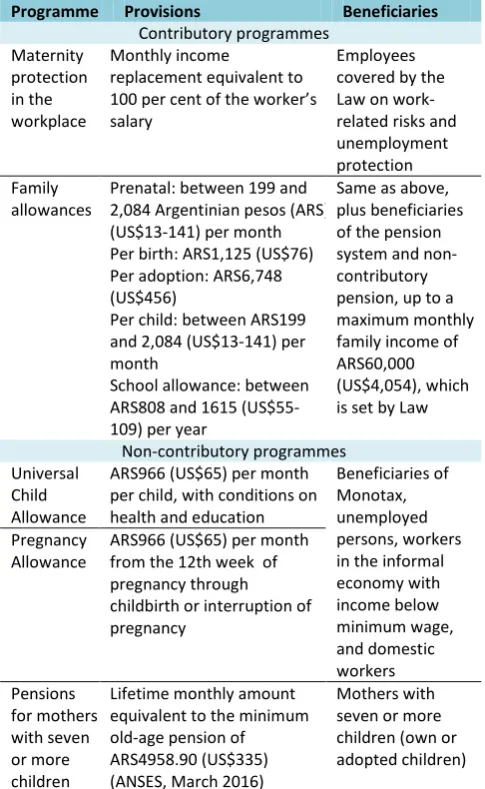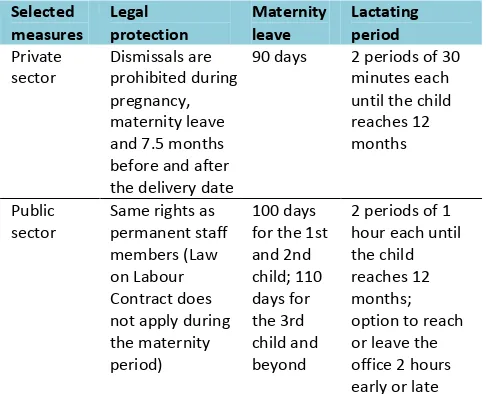Universal maternity protection
Argentina
Argentina’s Constitution provides for the protection of pregnant and lactating female workers. Argentina’s maternity protection policy is in coherence with the Social Protection Floors Recommendation, 2012 (No.202).
In Argentina, social protection in the case of maternity includes maternity protection in the workplace, contributory and non-contributory family allowances and pensions for mothers with seven or more children. In addition, several programmes provide universal access to basic social services. For example, the SUMAR Programme offers basic health services, including antenatal and postnatal consultations and delivery. The national legal framework also provides paid and unpaid maternity leave and paid paternity leave for registered workers.
Main lessons learned
• Maternity protection in Argentina
encompasses both transfers in cash and in kind and this makes it coherent with the ILO’s Recommendation No. 202. Maternity
protection includes income security
measures through several social transfer programmes, universal access to basic social services and provisions for maternity leave. Universal maternity protection in Argentina has had impressive results; child and maternal mortality have decreased by 34 per cent and 24 per cent respectively.
• The contributory and non-contributory programmes are administered by the National Social Security Administration
(ANSES) while complementary health
programmes are operated or regulated by the National Health Ministry. Therefore, good coordination among institutions is required to guarantee comprehensive maternity protection.
• The establishment of an adapted legal framework ensures the sustainability of social protection programmes.
S
o
ci
a
l P
ro
te
ct
io
n
in
A
ct
io
n
:
B
u
ild
in
g
S
o
ci
a
l P
ro
te
ct
io
n
F
lo
o
rs
Ju
n
e
2
0
16
1. Towards universal maternity protection
Maternity protection in Argentina encompasses both transfers in cash and in kind. It includes income security measures through social transfer programmes, universal access to basic social services and provisions for maternity leave. In this way, Argentina’s maternity protection policy is in line with the Social Protection Floors Recommendation, 2012 (No.202).
2. How is the system organized?
Contributory programmes include maternity protection in the workplace and family allowances. To extend maternity protection to uncovered groups, two non-contributory allowances were established in 2009 and 2011, respectively: the Universal Child Allowance (Asignación Universal por Hijo) and the Pregnancy Allowance (Asignación por Embarazo).
Table 1. Social transfer programmes
Programme Provisions Beneficiaries
Contributory programmes Maternity
protection in the workplace
Monthly income
replacement equivalent to 100 per cent of the worker’s salary
Employees covered by the Law on work-related risks and unemployment protection Family
allowances
Prenatal: between 199 and 2,084 Argentinian pesos (ARS) (US$13-141) per month Per birth: ARS1,125 (US$76) Per adoption: ARS6,748 (US$456)
Per child: between ARS199 and 2,084 (US$13-141) per month
School allowance: between ARS808 and 1615 (US$55-109) per year
Same as above, plus beneficiaries of the pension system and non-contributory pension, up to a maximum monthly family income of ARS60,000 (US$4,054), which is set by Law
Non-contributory programmes Universal
Child Allowance
ARS966 (US$65) per month per child, with conditions on health and education
Beneficiaries of Monotax, unemployed persons, workers in the informal economy with income below minimum wage, and domestic workers Pregnancy
Allowance
ARS966 (US$65) per month from the 12th week of pregnancy through childbirth or interruption of pregnancy
Pensions for mothers with seven or more children
Lifetime monthly amount equivalent to the minimum old-age pension of ARS4958.90 (US$335) (ANSES, March 2016)
Mothers with seven or more children (own or adopted children)
Source: Decree 1141/2015-Family allowances from March 2016 onwards
The contributory and non-contributory programmes are administered by the National Social Security Administration (ANSES). Out of a total of 13 million children and teenagers below the age of 18 years, the Universal Child Allowance and Pregnancy Allowance cover 7 million, a coverage rate of 53.8 per cent. In addition, income tax reductions are applied to families with children. The combination of the two programmes and income tax deductions brings the coverage to 74.3 per cent of all children below the age of 18 years. At the same time, the National Commission for Social Pensions of the Ministry of Social Development administers the pensions for mothers with seven or more children.
As far as universal access to basic social services is concerned, female workers in the formal economy can access social health services provided by trade unions. They can also access prepaid health-care services in private clinics and sanatoriums. The SUMAR Programme plays an important role, as it provides access to basic health care to vulnerable families with the objective to reduce child and maternal mortality, strengthen access to health care for school age children and teenagers and improve the overall care provided to women through regular health check-ups.
Table 2. Health services
Sub-system Institutions Coverage
Public system
Public provincial and district hospitals, as well as primary health centres
Provides health services to the entire population SUMAR Programme
Essential Public Health Functions Programme (FESP)
Remediar and Redes Programmes
Provides health services to the vulnerable population
System of social services
National social services system
Covers health risks for salaried workers and their families Private
subsystem
Enterprises providing prepaid health packages in sanatoriums and private clinics
Provides coverage to those who pay a premium
Source: ILO, Social Protection Platform (www.social-protection.org)
The SUMAR Programme was created in 2012 in the context of the extension of coverage of the Plan Nacer (2005). The SUMAR Programme facilitated access to health care for pregnant women and children up to 6 years of age. It was then extended to children and teenagers of between 6 and 19 years of age, and consequently to men and women of 20 to 64 years of age who are without any contributory social health
protection. In 2015 the SUMAR Programme covered 13 million people. According to the 2010 national census, the population without any social health protection was 14 million. Therefore, the SUMAR Programme has contributed significantly to closing the social health protection gap in Argentina.
The programme is run by the National Health Ministry and financed from public budget. It is linked with the Universal Child Allowance and Pregnancy Allowance.
In addition, the national legal framework includes paid and unpaid maternity leave for female workers in registered or formal employment. Although there are some differences between the maternity leave policies in the public and private sectors, in both cases the benefits are set at 100 per cent of a worker’s salary during the entire maternity leave period. The benefits are financed by social security.
Table 3. Maternity leave in the registered or formal sector
Selected measures
Legal protection
Maternity leave
Lactating period
Private sector
Dismissals are prohibited during pregnancy, maternity leave and 7.5 months before and after the delivery date
90 days 2 periods of 30
minutes each until the child reaches 12 months
Public sector
Same rights as permanent staff members (Law on Labour Contract does not apply during the maternity period)
100 days for the 1st and 2nd child; 110 days for the 3rd child and beyond
2 periods of 1 hour each until the child reaches 12 months; option to reach or leave the office 2 hours early or late Source: Law No. 20.744 on the work contract and Law No. 25.164 on the regulation of the national public employment
At the end of their maternity leave, mothers can take an unpaid leave called “excedencia” to take care of their child during the first year of life. The unpaid maternity leave only applies to female workers in registered paid employment.
Men are entitled to paternity leave of between two and five days and are not entitled to unpaid leave.
3. What are the main impacts on people’s lives?
Over the last ten years, maternity protection coverage was increased and reinforced by linkages and synergies between the various programmes. Due to major
affiliation efforts of the SUMAR Programme, 230,000 children have registered for the Universal Child Allowance and, in 2014, 47,000 women automatically received the Pregnancy Allowance.
The existing Universal Child Allowance and Pregnancy Allowance combined with income tax deductions for families with children benefit 74.3 per cent of all children below the age of 18 years. The SUMAR Programme also had a significant impact on Argentina’s population by facilitating access to health care for 13 million people. These interventions have contributed to improving the quality of life of the most vulnerable families in Argentina and their implementation signifies substantial progress in the fight against poverty.
The linkages that exist between the Universal Child Allowance and Pregnancy Allowance contributed to an increase in the enrolment of children and pregnant women in the SUMAR Programme by 50 per cent and 14 per cent respectively, in 2014. Due to the extension of maternity protection in the past decade, child and maternal mortality have been reduced by 34 per cent and 24 per cent respectively. The SUMAR Programme has been recognized by the Geneva Health Forum and highlighted as a model and source of inspiration for other countries (Ministry of Health, 2015).
4. What are the main challenges?
One of the main challenges is including the right to care as one of the components of the social protection system (ILO, 2014). Recommendations to ensure that the right to care becomes a reality include:
• ratify ILO’s Maternity Protection Convention, 2000 (No. 183), in order to extend the duration of maternity leave from 12 to 14 weeks;
• create the necessary legal framework to ensure that enterprises that employ a certain number of female workers establish maternity rooms and childcare centres, in line with ILO’s Workers with Family Responsibilities Convention, 1981 (No. 156), that was ratified by Argentina in 1988;
• promote fathers’ co-responsibility in childcare by extending paternity leave to uncovered groups and increasing the duration of the paternity leave; • improve compliance with the Labour Law through
prevention and inspection measures; and
• extend maternity leave to female workers in the informal economy.
REFERENCES
ANSES. 2015. Administración Nacional de la Seguridad Social (Buenos Aires). Available at: www.anses.gob.ar.
ILO. 2009. Protección de la maternidad, Notas OIT sobre Trabajo y Familia No. 4. Available at: www.ilo.org/americas/publicaciones/notas-trabajo-y-familia/lang--es/index.htm.
—. 2010. Maternity at work: A review of national legislation, second edition (Geneva). Available at:
www.ilo.org/global/publications/ilo-bookstore/order-online/books/WCMS_142159/lang--es/index.htm.
—. 2012a. Avances en la consolidación de la protección social en Argentina, Notas OIT (Buenos Aires, Trabajo decente en Argentina). Available at:
www.ilo.org/buenosaires/publicaciones/notas-trabajo-decente/WCMS_221702/lang--es/index.htm.
—. 2012b. Social Protection Floors Recommendation (No. 202). Available at:
http://www.ilo.org/dyn/normlex/en/f?p=NORMLEXPUB:12100:0::NO::P12100_INSTRUMENT_I D:3065524.
—. 2014. Recibir y brindar cuidados en condiciones de equidad: Desafíos de la protección social y las políticas de empleo en Argentina, Documento de Trabajo No. 5 (Buenos Aires). Available at: www.ilo.org/buenosaires/publicaciones/WCMS_302535/lang--es/index.htm.
Ministerio de Salud de la Nación. 2013. Plan para la reducción de la mortalidad materno-infantil de las mujeres y las adolescents (Buenos Aires). Available at: www.msal.gov.ar/plan-reduccion-mortalidad.
—. 2014. Memoria Anual, Programa Sumar, 2013 (Buenos Aires). Available at: www.msal.gov.ar/sumar/images/stories/pdf/memoria-anual-sumar-2013.pdf.
—. 2015. Programa SUMAR (Buenos Aires). Available at: www.msal.gov.ar/sumar.
Building Social
Protection Floors
Country Note Series
June 2016
This note was produced by Analía Calero. It was reviewed by Isabel Ortiz, Valérie Schmitt, Fabio Durán and Victoria Giroud of the ILO.
The editor of the series is Isabel Ortiz, Director of the
Social Protection Department, International
Labour Organization (ILO).
For more information, contact: [email protected]
www.social-protection.org
INTERNATIONAL LABOUR OFFICE
4, route des Morillons 1211 Geneva 22 Switzerland
Follow us on:
www.facebook.com/SPplatform
www.linkedin.com/company/social-protection-platform www.twitter.com/soc_protection
www.youtube.com/user/ILOTV

